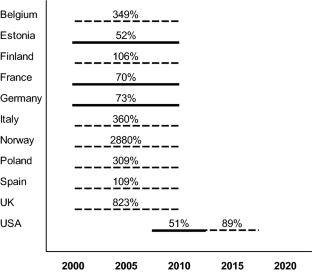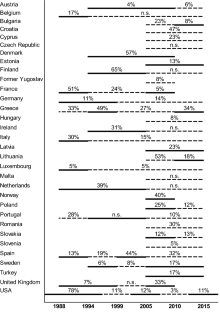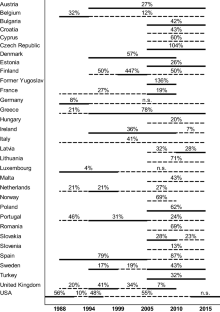Leisure: Definitions, Trends, and Policy Implications

Economic theories predict that with modernity and with the increase in standards of living, individuals will aspire for more leisure. However, the results of empirical studies which examined period trends in leisure time across developed countries do not confirm this presumption. The current study asks: If changes in leisure stem from ideational changes among different generations, will trends in leisure look different if examined across cohorts, or if measured differently? By integrating theoretical definitions of leisure based on literatures in economics, sociology, and psychology, this research derives three main macro-level empirical measures of leisure from various sources. These measures are used to analyze the contribution of population turnover to changes in the quantity of leisure, in developed countries, using linear regression decomposition method. Our results show an almost unequivocal increase in leisure across cohorts, across 159 country-periods, suggesting that new policies supporting domestic consumption are warranted.
This is a preview of subscription content, log in via an institution to check access.
Access this article
Subscribe and save
Springer+ Basic
€32.70 /Month
- Get 10 units per month
- Download Article/Chapter or eBook
- 1 Unit = 1 Article or 1 Chapter
- Cancel anytime
Buy Now
Price includes VAT (France)
Instant access to the full article PDF.
Rent this article via DeepDyve




Similar content being viewed by others

Leisure and Consumer Behavior: A “Social Indicators” Update
Chapter © 2015

Peter Nijkamp Recommends “The False Duality of Work and Leisure” by Joy E. Beatty and William R. Torbert
Chapter © 2019

Introduction to the Palgrave Handbook of Leisure Theory
Chapter © 2017
Notes
Macro-level indicators are provided by age groups according to the following: US time-use data—15–24, 25–34, 35–44, 45–54, 55–64, 65–74; Eurostat’s time-use data—15–19, 20–24, 25–44, 45–64, 65–74; US Expenditures data—15–24, 25–34, 35–44, 45–54, 55–64, 65–74, 75–84; Eurostat’s expenditures data—14–29, 30–44, 45–59, 60–74.
The percent of change explained by cohort replacement is calculated by dividing the cohort replacement effect by the total expected change.
The percent recovered due to cohort replacement is calculated by dividing the cohort replacement effect by the inverse value of the “within cohort change.”.
References
- Aguiar, M., & Hurst, E. (2007). Measuring trends in leisure: The allocation of time over five decades. The Quarterly Journal of Economics,122(3), 969–1006. ArticleGoogle Scholar
- Argyle, M. (1996). Subjective well-being. In A. Offer (Ed.), In Pursuit of the quality of life (pp. 18–45). Clarendon Press. Google Scholar
- Ashe, M. C., Miller, W. C., Eng, J. J., & Noreau, L. (2008). Older adults, chronic disease and leisure-time physical activity. Gerontology,55, 64–72. ArticleGoogle Scholar
- Bauman, Z. (2001). Consuming life. Journal of Consumer Culture,1(1), 9–29. ArticleGoogle Scholar
- Becker, G. S. (1965). A theory of the allocation of time. The Economic Journal,75, 493–517. ArticleGoogle Scholar
- Becker, G. S. (1991). A treatise on the family. Harvard University Press. BookGoogle Scholar
- Billari, F., & Kohler, H. P. (2004). Patterns of low and lowest-low fertility in Europe. Population Studies,58(2), 161–176. ArticleGoogle Scholar
- Bittman, M. (2002). Social participation and family welfare: The money and time costs of leisure in Australia. Social Policy & Administration,36(4), 408–425. ArticleGoogle Scholar
- Bittman, M., & Wajcman, J. (2000). The rush hour: The character of leisure time and gender equity. Social Forces,79(1), 165–189. ArticleGoogle Scholar
- Brewster, K. L., & Padavic, I. (2000). Change in gender-ideology, 1977–1996: The contributions of intracohort change and population turnover. Journal of Marriage and Family,62(2), 477–487. ArticleGoogle Scholar
- Cantwell, M. L., & Sanik, M. M. (1993). Leisure before and after parenthood. Social Indicators Research,30(2), 139–147. ArticleGoogle Scholar
- Chidambaram, B., & Scheiner, J. (2021). Leisure quality among German parents: Exploring urbanity, mobility, and partner interaction as determinants. Sustainability,13(11), 5883. ArticleGoogle Scholar
- Claxton, A., & Perry-Jenkins, M. (2008). No fun anymore: Leisure and marital quality across the transition to parenthood. Journal of Marriage and Family,70(1), 28–43. ArticleGoogle Scholar
- Coleman, J. S. (1990). Foundations of social theory. Belknap Press. Google Scholar
- Craig, L., & Mullan, K. (2013). Parental leisure time: A gender comparison in five countries. Social Politics,20, 329–357. ArticleGoogle Scholar
- Crawford, D. W., Houts, R. M., Huston, T. L., & George, L. J. (2002). Compatibility, leisure, and satisfaction in marital relationships. Journal of Marriage and Family,64(2), 433–449. ArticleGoogle Scholar
- Cushman, G., & Laidler, A. (1990). Recreation, Leisure and Social Policy. Occasional Paper No. 4. Department of Parks, Recreation & Tourism, Lincoln University. Google Scholar
- De Ruijter, E., & Van Der Lippe, T. (2009). Getting outside help: How trust problems explain household differences in domestic outsourcing in the Netherlands. Journal of Family Issues,30(1), 3–27. ArticleGoogle Scholar
- Esping-Andersen, G. (1990). The three worlds of welfare capitalism. Princeton University Press. Google Scholar
- European Commission. (2019). Eurostat Online Database.
- Firebaugh, G. (1989). Methods for estimating cohort replacement effects. In C. Clogg (Ed.), Sociological methodology (pp. 243–262). Basil Blackwell. Google Scholar
- Firebaugh, G. (1997). Analyzing repeated surveys (p. 34). Sage Publications. BookGoogle Scholar
- Firebaugh, G., & Davis, K. E. (1988). Trends in anti- black prejudice, 1972–1984: Region and cohort effects. American Journal of Sociology,94, 251–272. ArticleGoogle Scholar
- Fosse, E., & Winship, C. (2019). Analyzing age-period-cohort data: A review and critique. Annual Review of Sociology,45, 467–492. ArticleGoogle Scholar
- Frejka, T. (2008). Overview Chapter 2: Parity distribution and completed family size in Europe: Incipient decline of the two-child family model. Demographic Research,19(4), 47–72. ArticleGoogle Scholar
- Frejka, T., & Calot, G. (2001). Cohort reproductive patterns in low-fertility countries. Population and Development Review,27(1), 103–132. ArticleGoogle Scholar
- Gershuny, J. (2000). Changing times: Work and leisure in postindustrial society. Oxford University Press. Google Scholar
- Gershuny, J. (2013). National utility: Measuring the enjoyment of activities. European Sociological Review,29(5), 996–1009. ArticleGoogle Scholar
- Gimenez-Nadal, J. I., & Ortega-Lapiedra, R. (2010). Self-employment and time stress: The effect of leisure quality. Applied Economics Letters,17, 1735–1739. ArticleGoogle Scholar
- Gimenez-Nadal, J. I., & Sevilla, A. (2012). Trends in time allocation: A cross-country analysis. European Economic Review,56(6), 1338–1359. ArticleGoogle Scholar
- Goodin, R. E., Rice, J. M., Bittman, M., & Saunders, P. (2005). The time-pressure illusion: Discretionary time vs. free time. Social Indicators Research,73(1), 43–70. ArticleGoogle Scholar
- Gornick, J. C., Meyers, M. K., & Ross, K. E. (1997). Supporting the employment of mothers: Policy variation across fourteen welfare states. Journal of European Social Policy,7(1), 45–70. ArticleGoogle Scholar
- Greenwood, J., & Vandenbroucke, G. (2008). Hours Worked (long-run trends). The New Palgrave Dictionary of Economics,1–8, 2793–2799. Google Scholar
- Gronau, R. (1977). Leisure, home production, and work - the theory of the allocation of time revisited. Journal of Political Economy,85(6), 1099–1123. ArticleGoogle Scholar
- Gronau, R. (1986). Home production: A survey. Handbook of Labor Economics,1, 273–304. ArticleGoogle Scholar
- Grøntved, A., & Hu, F. B. (2011). Television viewing and risk of type 2 diabetes, cardiovascular disease, and all-cause mortality: A meta-analysis. JAMA,305, 2448–2455. ArticleGoogle Scholar
- Guryan, J., Hurst, E., & Kearney, M. (2008). Parental education and parental time with children. The Journal of Economic Perspectives,22(3), 23. ArticleGoogle Scholar
- Hakim, C. (2000). Work-lifestyle choices in the 21st century: Preference theory. Oxford University Press. Google Scholar
- Hakim, C. (2003). A new approach to explaining fertility patterns: Preference theory. Population and Development Review,29(3), 349–374. ArticleGoogle Scholar
- Halldén, K.& Stenberg, A. (2012). Domestic services and female earnings: Panel microdata evidence from a reform. Unpublished Manuscript, Swedish Institute for Social Research, Stockholm University. Retrieved from http://sole-jole.org/13189.pdf
- Hellstrand, J., Myrskylä, M., & Nisén, J. (2019). All-time low period fertility in Finland: Drivers, tempo effects, and cohort implications. MPIDR Working Paper 2019–006. Max Planck Institute for Demographic Research. Retrieved from https://www.demogr.mpg.de/papers/working/wp-2019-006.pdf
- Holford, T. R. (1991). Understanding the effects of age, period, and cohort on incidence and mortality rates. Annual Review of Public Health,12(1), 425–457. ArticleGoogle Scholar
- Inglehart, R. (1977). The silent revolution: Changing values and political styles among western publics. Princeton University Press. Google Scholar
- Inglehart, R. (1997). Modernization and postmodernization: Cultural, economic, and political change in 43 societies. Princeton University Press. BookGoogle Scholar
- Jarosz, E. (2016). The duration and dynamics of leisure among the working population in Poland. A time-use approach. World Leisure Journal,58(1), 44–59. ArticleGoogle Scholar
- Jeffres, L. W., & Dobos, J. (1993). Perceptions of leisure opportunities and the quality of life in a metropolitan area. Journal of Leisure Research,25(2), 203. ArticleGoogle Scholar
- Juster, F. T., & Stafford, F. P. (1991). The allocation of time: Empirical findings, behavioral models, and problems of measurement. Journal of Economic Literature,29(2), 471–522. Google Scholar
- Kahneman, D., Krueger, A., Schkade, D., Schwarz, N., & Stone, A. (2004). A survey method for characterizing daily life experience: The day reconstruction method. Science,3, 1776–1780. ArticleGoogle Scholar
- Katz-Gerro, T., & Sullivan, O. (2010). Voracious cultural consumption: The intertwining of Gender and social status. Time & Society,19(2), 193–219. ArticleGoogle Scholar
- Knoester, C., & Eggebeen, D. J. (2006). The effects of the transition to parenthood and subsequent children on men’s well-being and social participation. Journal of Family Issues,27(11), 1532–1560. ArticleGoogle Scholar
- Krueger, A. B. (2007). Are we having more fun yet? Categorizing and evaluating changes in time allocation. Brookings Papers on Economic Activity,2007(2), 193–215. ArticleGoogle Scholar
- Kuhn, T.S. (2012 [1962]). The structure of scientific revolutions: 50th Anniversary edition. Chicago University Press.
- Lee, J. W., & Barro, R. J. (2001). Schooling quality in a cross-section of countries. Economica,68(272), 465–488. ArticleGoogle Scholar
- Lesthaeghe, R. (1983). A century of demographic and cultural change in Western Europe: An exploration of underlying dimensions. Population and Development Review,9, 411–435. ArticleGoogle Scholar
- Lesthaeghe, R. (2010). The unfolding story of the second demographic transition. Population and Development Review,36(2), 211–251. ArticleGoogle Scholar
- Lesthaeghe, R. (2014). The second demographic transition: A concise overview of its development. Proceedings of the National Academy of Sciences United States of America,111(51), 18112–18115. ArticleGoogle Scholar
- Lesthaeghe, R. J., & Neidert, L. (2006). The second demographic transition in the United States: Exception or textbook example? Population and Development Review,32(4), 669–698. ArticleGoogle Scholar
- Lesthaeghe, R., & Surkyn, J. (1988). Cultural dynamics and economic theories of fertility change. Population and Development Review,14, 1–45. ArticleGoogle Scholar
- Lesthaeghe, R., & Van de Kaa, D. J. (1986). Twee demografische transities (pp. 9–24). Groei en krimp. Google Scholar
- Leung, L., & Lee, P. S. N. (2005). Multiple determinants of life quality: The roles of Internet activities, use of new media, social support, and leisure activities. Telematics and Informatics,22, 161–180. ArticleGoogle Scholar
- Lloyd, K. M., & Auld, C. J. (2002). The role of leisure in determining quality of life: Issues of content and measurement. Social Indicators Research,57(1), 43–71. ArticleGoogle Scholar
- Luo, L., & Hodges, J. S. (2020). Constraints in random effects age-period-cohort models. Sociological Methodology,50(1), 276–317. ArticleGoogle Scholar
- Mannheim, K. (1952). The problem of generations. In P. Kecskemeti (Ed.), Essays on the sociology of knowledge (pp. 276–322). Routledge & Kegan Paul. Google Scholar
- Maslow, A. H. (1943). A theory of human motivation. Psychological Review,50(4), 370. ArticleGoogle Scholar
- Mattingly, M. J., & Blanchi, S. M. (2003). Gender differences in the quantity and quality of Free time: The US experience. Social Forces,81(3), 999–1030. ArticleGoogle Scholar
- McEachern, W. A. (2009). Macroeconomics: A contemporary Introduction. South-Western. Google Scholar
- Morel, N. (2015). Servants for the knowledge-based economy? The political economy of domestic services in Europe. Social Politics,22(2), 170–192. ArticleGoogle Scholar
- Myrskylä, M., Goldstein, J. R., & Cheng, Y. H. A. (2013). New cohort fertility forecasts for the developed world: Rises, falls, and reversals. Population and Development Review,39(1), 31–56. ArticleGoogle Scholar
- Passias, E. J., Sayer, L., & Pepin, J. R. (2017). Who experiences leisure deficits? Mothers’ marital status and leisure time. Journal of Marriage and Family,79, 1001–1022. ArticleGoogle Scholar
- Piga, G., & Pecchi, L. (2008). Revisiting keynes: Economic possibilities for our grandchildren. The MIT Press. Google Scholar
- Pollak, R. A. (2012). Allocating time: Individuals’ technologies, household technology, perfect substitutes, and specialization. Annals of Economics and Statistics,105–106, 75–97. ArticleGoogle Scholar
- Presser, H. B. (1989). Can we make time for children? The economy, work schedules, and child care. Demography,26(4), 523–543. ArticleGoogle Scholar
- Presser, H. B. (1999). Toward a 24-hour economy. Science,284(5421), 1778–1779. ArticleGoogle Scholar
- Presser, H. B. (2001). Comment: A gender perspective for understanding low fertility in post-transitional societies. Population and Development Review,27, 177–183. Google Scholar
- Raz-Yurovich, L. (2014). A transaction cost approach to outsourcing by households. Population and Development Review,40(2), 293–309. ArticleGoogle Scholar
- Raz-Yurovich, L. (2016). Outsourcing of housework and the transition to a second birth in Germany. Population Research and Policy Review,35(3), 401–417. ArticleGoogle Scholar
- Raz-Yurovich, L., & Marx, I. (2018). What does state-subsidized outsourcing of domestic work do for women’s employment? The Belgian service voucher scheme. Journal of European Social Policy,28(2), 104–115. ArticleGoogle Scholar
- Raz-Yurovich, L., & Marx, I. (2019). Outsourcing housework and highly skilled women’s labour force participation: An analysis of a policy intervention. European Sociological Review,35(2), 205–224. ArticleGoogle Scholar
- Roberts, K. (1978). Contemporary society and the growth of leisure. Longman. Google Scholar
- Roberts, K. (1999). The pluralist scenario. In C. Critcher, P. Bramham, & A. Tomlinson (Eds.), Sociology of leisure: A reader (pp. 236–246). E & FN Spon. Google Scholar
- Robinson, J. P., & Godbey, G. (1999). Time for life: The surprising ways Americans use their time. Pennsylvania State University Press. Google Scholar
- Rojek, C. (2005). Leisure theory: Principles and practice. Palgrave Macmillan. BookGoogle Scholar
- Ryder, N. B. (1965). The cohort as a concept in the study of social change. American Sociological Review,30, 843–861. ArticleGoogle Scholar
- Samuelson, P. A. (1948). Consumption theory in terms of revealed preference. Economica,15, 243–253. ArticleGoogle Scholar
- Schwartz, S. H. (1999). A theory of cultural values and some implications for work. Applied Psychology,48(1), 23–47. ArticleGoogle Scholar
- Schwartz, S. H. (2006). A theory of cultural value orientations: Explication and applications. Comparative Sociology,5(2), 137–182. ArticleGoogle Scholar
- Sevilla, A., Gimenez-Nadal, J. I., & Gershuny, J. (2012). Leisure inequality in the United States: 1965–2003. Demography,49(3), 939–964. ArticleGoogle Scholar
- Sobotka, T. (2008). Overview chapter 6: The diverse faces of the second demographic Transition In Europe. Demographic Research,19(8), 171–224. ArticleGoogle Scholar
- Stern, C., & Munn, Z. (2010). Cognitive leisure activities and their role in preventing dementia: A systematic review. International Journal of Evidence-Based Healthcare,8, 2–17. ArticleGoogle Scholar
- Sullivan, O. (1997). Time waits for no (wo)man: An investigation of the gendered experience of domestic time. Sociology,31(2), 221–239. ArticleGoogle Scholar
- Sullivan, O., Gershuny, J., & Robinson, J. P. (2018). Stalled or uneven gender revolution? A long-term processual framework for understanding why change is slow. Journal of Family Theory & Review,10(1), 263–279. ArticleGoogle Scholar
- Twenge, J. M. (2010). A review of the empirical evidence on generational differences in work attitudes. Journal of Business and Psychology,25(2), 201–210. ArticleGoogle Scholar
- Twenge, J. M., Campbell, S. M., Hoffman, B. J., & Lance, C. E. (2010). Generational differences in work values: Leisure and extrinsic values increasing, social and intrinsic values decreasing. Journal of Management,36(5), 1117–1142. ArticleGoogle Scholar
- United Nations. (2018). Classification of Individual Consumption according to Purpose (COICOP). Retrieved from https://unstats.un.org/unsd/classifications/unsdclassifications/COICOP_2018_-_pre-edited_white_cover_version_-_2018-12-26.pdf
- US Bureau of Labor Statistics. (2019). American Time Use Survey.
- Veblen, T. (2009). The Theory of the Leisure Class. Oxford University Press. BookGoogle Scholar
- Verbakel, E. (2013). Leisure values of Europeans from 46 countries. European Sociological Review,29(3), 669–682. ArticleGoogle Scholar
- WVS. (2019). World Value Survey 1981–2016 Longitudinal Aggregate. World Values Survey Association (www.worldvaluessurvey.org). Aggregate File Producer: JDSystems Data Archive, Madrid, Spain.
- Zeman, K., Beaujouan, É., Brzozowska, Z., & Sobotka, T. (2018). Cohort fertility decline in low Fertility countries: Decomposition using parity progression ratios. Demographic Research,38, 651–690. ArticleGoogle Scholar
Acknowledgements
I gratefully acknowledge the excellent comments and advices received from Barbara S. Okun (The Hebrew University of Jerusalem), Anat Gofen (The Hebrew University of Jerusalem), Brienna Perelli-Harris (University of Southampton), and Michaela Kreyenfeld (Hertie School of Governance) at the early stages of this research. I also gratefully acknowledge the excellent research assistance of Alon Pertzikovitz.
Author information
Authors and Affiliations
- Department of Sociology, Demographic Studies, The Federmann School of Public Policy and Government, The Hebrew University of Jerusalem, Jerusalem, Israel Liat Raz-Yurovich
- Liat Raz-Yurovich





